Singapore
Singapore, officially the Republic of Singapore, is a sovereign country as well as a city-state. It is an island state at the southern end of the Malay Peninsula in Asia, between the Straits of Malacca and the South China Sea. Singapore is about one degree of latitude (137 kilometres or 85 miles) north of the equator. About 5.70 million people live in Singapore. About 3.31 million are citizens. Most of them are ethnically Chinese, Malay, or Indian, as well as a smaller number of other Asians and Europeans.
| Motto: Majulah Singapura (Malay) (English: "Onward, Singapore") | |
| Anthem: Majulah Singapura (English: "Onward, Singapore") | |
 | |
| Capital | Singapore[a] 1°17′N 103°50′E / 1.283°N 103.833°E |
| Official languages | |
| National language | Malay |
| Ethnic groups (2019)[2] | |
| Religion (2015) | List of religions
|
| Demonym(s) | Singaporean |
| Government | Unitary dominant-party parliamentary constitutional republic |
| Tharman Shanmugaratnam | |
| Lee Hsien Loong | |
| Sundaresh Menon | |
| Seah Kian Peng | |
| Legislature | Parliament |
| Independence from the United Kingdom and Malaysia | |
| 3 June 1959 | |
| 16 September 1963 | |
| 9 August 1965 | |
| 8 August 1967 | |
| Area | |
• Total | 731.0 km2 (282.2 sq mi)[3] (176th) |
| Population | |
• 2019 estimate | |
• Density | 7,804/km2 (20,212.3/sq mi) (2nd) |
| GDP (PPP) | 2020 estimate |
• Total | |
• Per capita | |
| GDP (nominal) | 2020 estimate |
• Total | |
• Per capita | |
| Gini (2017) | medium |
| HDI (2019) | very high · 11th |
| Currency | Singapore dollar (S$) (SGD) |
| Time zone | UTC+8 (Singapore Standard Time) |
| Date format | dd/mm/yyyy |
| Mains electricity | 230 V–50 Hz |
| Driving side | left |
| Calling code | +65 |
| ISO 3166 code | SG |
| Internet TLD | .sg |
Website gov | |
Present-day Singapore was founded in 1819 by Stamford Raffles as a trading post of the British Empire. During the Second World War, Singapore was taken over by Japan in 1942, but returned to British control after Japan surrendered in 1945. Singapore started to govern itself in 1959, and in 1963 became part of the new federation of Malaysia, together with Malaya, North Borneo, and Sarawak. Political and social differences led to Singapore being removed from the federation two years later, then becoming an independent country on its own.
Most Singaporeans are bilingual.[8] The symbolic national language of Singapore is Malay. Other official languages of Singapore are English, Mandarin and Tamil.[9] English is the language of choice because everyone in Singapore knows and uses it. It is the first language taught in schools and the language used by the government and in court. Students are also usually taught the language of their ethnicity. This means that the Chinese will learn Mandarin, Malays will learn Malay, and so on. Students can also choose to learn a third language in secondary school.
Singapore is also known as a "Garden City" or a "City in a Garden". This is because there are plants everywhere, making it look like a garden.[10] Singapore has one of the highest standards of living in the world, with very good education, healthcare, housing, and very low corruption. It is also known for having many strict rules and punishments, including fines.[11][12] This is why it is also sometimes jokingly called a "fine" city. The government says this has helped Singapore be a very safe country.[13] Singapore is one of the founding members of ASEAN.
History
Before 1819
Singapore's name comes from 'Singa Pura', which means Lion City in Sanskrit. Many people around the world understand "Lion City" to refer to Singapore.[14] There is some debate about who founded Singapore. According to the Malay Annals, a Sumatran prince called Sang Nila Utama landed on Temasek (Singapore's old name) and saw a Lion which is called 'Singa' in Malay.[15] Thus he gave the island a new name, 'Singapura'.[16] However, Sang Nila Utama was likely mistaken, as lions never existed in Singapore. It is believed that the "lion" was actually a Malayan Tiger, which also exists in neighbouring Malaysia. While now extinct in Singapore it used to be present back then.[17]
There were also many pieces of old items, such as Chinese coins, that showed that Temasek was an important Asian trading port even before the British rule.[18][19]
1819 to 1942
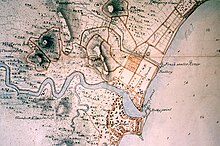
Few people lived in Singapore at the beginning of the 19th century. British governor Stamford Raffles arrived in Singapore on 28 January 1819 and wanted to set up a British trading town.[20] At the time, the island was then ruled by Tengku Abdul Rahman, the Sultan of Johor, who the Dutch and the Bugis from Sulawesi had controlled.[21] However, the Sultanate was weakened by infighting: the Temenggong (Chief Minister) of Tengku Abdul Rahman, as well as his officials, supported the Sultan's elder brother Tengku Long, who was living in exile in Riau.
With the Temenggong's help, Raffles managed to secretly bring Tengku Long back into Singapore. Raffles offered to recognize Tengku Long as the true Sultan of Johor, under the title of Sultan Hussein, as well as giving him $5000 per year and another $3000 to the Temenggong; in return, Sultan Hussein would give the British the right to establish a trading post on Singapore.[22] An official treaty was signed on 6 February 1819.[23][24]
In 1824, another treaty with the Sultan led to the entire island becoming under the British.[25] In 1826, Singapore became part of the Straits Settlements. Singapore became the regional capital in 1836.[26] Before Raffles arrived, there were only about a thousand people living on the island, mostly Malays along with a handful of Chinese.[27] By 1860, the population had grown to over 80,000, more than half being Chinese.[25][28] The country was given colony status in 1867. Later, in the 1890s, when the rubber industry became established in Malaya and Singapore, the island became a global center for sorting rubber and exporting them.[25][29]
World War I
Singapore was not really affected by the First World War (1914–18), as the conflict did not spread to Southeast Asia. The only significant event during the war was the 1915 Singapore Mutiny by Muslim soldiers from British India, who were stationed in Singapore.[30] After hearing news that they were to be sent to fight the Ottoman Empire in Europe, a Muslim state, the soldiers killed their officers and several British civilians before the mutiny was stopped by non-Muslim troops arriving from Johore and Burma.[31]
Interwar period
After World War I, the British built the large Singapore Naval Base as part of the defensive Singapore strategy.[32] First announced in 1921, the construction of the base went at a slow pace until the Japanese invasion of Manchuria in 1931. Costing $60 million and not fully completed in 1938, it was the largest dry dock in the world, the third-largest floating dock, and had enough fuel tanks to support the entire British Navy for six months.[32][33] The base was defended by heavy naval guns stationed at Fort Siloso, Fort Canning and Labrador Park, as well as a Royal Air Force airfield at Tengah Air Base. Winston Churchill called Singapore the "Gibraltar of the East", and military discussions often referred to the base as just "East of Suez".[34]
However, the main fleet was in Europe, and the British did not have enough money to build a second fleet to protect their Asian colonies. The plan was for the Home Fleet to sail quickly to Singapore in the event of an emergency. As a result, after World War II broke out in 1939, the fleet was busy defending Britain from Germany, leaving Singapore open for a Japanese invasion.[35][36]
World War II

Due to the weak defenses of the country, the Japanese attacked Singapore and easily took control of the colony on 15 February 1942. Up to 60,000 British soldiers surrendered on that day, and Churchill called it "the worst disaster and largest capitulation in British history".[37] There were a lot of losses by both the British and the rest of the Empire, with a total of nearly 85,000 people captured.[38] About 5,000 were killed or injured, many from Australia and India.
People of Singapore went through hard times during the Japanese rule, until the surrender of the Japanese in September of 1945. Many people were tortured or killed by the Japanese as they did not follow the rules properly or because they were suspected of going against the Japanese. The Japanese also targeted the Chinese the most; between 5,000 and 25,000 Chinese were killed, now known as the Sook Ching massacre.[39] The most notable anti-Japanese force was Force 136, headed by Lim Bo Seng. Its purpose was to encourage and supply resistance movements in the enemy-occupied territory and occasionally mount sabotage operations.[40]
The hard times during World War II made the people think that the British were not as strong as before. Therefore, many people were supportive of independence once the British had returned.[41][42]
Independence
A few years after the war, In 1963, Singapore joined with Malaya, Sabah and Sarawak to form the new nation of Malaysia. Malaysia is a country with many races. In Malaya, only the Malays have special benefits. For example, the Malays could get university education more easily than other races.
As most people in Singapore are Chinese, Singapore wanted equality for all the people of Malaysia. Singapore also wanted a common market to be set up so that goods to Malaysia would not be taxed. However, this was not done and caused arguments between the state government of Singapore and the federal government of Malaysia.[43]
Singapore separated from Malaysia and became independent on its own on 9 August 1965.[44]
After Independence
After Independence, the president of Singapore was Yusof Ishak and its prime minister was Lee Kuan Yew.[45]At first, many people thought Singapore's independence would not last.[46] In 1967, Singapore helped to start the Association of Southeast Asian Nations and in 1970 it joined the Non-Aligned Movement.[47] Lee Kuan Yew was in charge of the country as Prime Minister of Singapore and saw it become very developed.[48][49][50]
In 1990, Goh Chok Tong replaced Lee Kuan Yew as prime minister, while Lee Kuan Yew became Senior Minister. When Goh Chok Tong was Prime Minister, Singapore went through the 1997 Asian financial crisis, the 2003 SARS outbreak and terrorist threats by Jemaah Islamiyah. In 2004, Lee Hsien Loong, the son of Lee Kuan Yew, took over as Prime Minister. Goh Chok Tong became the Senior Minister, and Lee Kuan Yew became the Minister Mentor of Singapore. Lee Kuan Yew died in 2015.[51]
Government and politics

Singapore is a parliamentary republic with a Westminster system of unicameral parliamentary government representing constituencies. Its constitution states representative democracy as its political system.[52] Singapore is ranked regularly as one of the least corrupt countries in the world, according to Transparency International.[53]
The Cabinet has executive power, and is led by the Prime Minister, and the President.[54] The president is elected through popular vote, and has some veto powers for a few big decisions such as the use of the national reserves and the appointment of judges, but otherwise occupies a post with little power.[55]
The Parliament serves as the legislative branch of government.[54] Members of Parliament (MPs) are made up of elected, non-constituency and nominated members. Elected MPs are voted into parliament on a "first-past-the-post" (plurality) system and represent either single-member or group-representation constituencies.[56] Elections are free, and the People's Action Party has won control of Parliament with large majorities in every election since self-governance in 1959.[57] In the most recent parliamentary elections in 2020, the largest opposition, led by the Workers' Party, increased its representation in the House to 10 elected MPs out of 93.[58]
The legal system of Singapore is based on English common law, however with large and important local differences. Trial by jury was removed in 1970 leaving judicial judgement done completely and only by judgeship.[59] Singapore has laws that include corporal punishment in the form of caning for rape, rioting, vandalism, and some immigration crimes.[60][61] There is a mandatory death penalty for murder, and for certain drug-trafficking and firearms offences.[62] In a 2008 survey, international business executives believed Singapore had the best judicial system in Asia.[63]
People
Religion
Buddhism is the most common religion in Singapore.[64] Other common religions include: Christianity, Islam, Taoism, and Hinduism.[64]
Education
Students in Singapore go through six years of compulsory primary school. During the six years, students' learning is focused on English, mother tongue, mathematics and science.[66] At the end of the six years, all students take the Primary School Leaving Examination (PSLE).[67]
Depending on their results in the PSLE, students are streamed into "Special", "Express", "Normal (Academic)", and "Normal (Technical)" groups.[68] The amount of time a student spends studying in Secondary school (4–5 years) depends on their group.[68]
Students are taught in English, and their mother tongue, which can be Chinese, Malay or Tamil. Secondary school students may also choose to study a third language such as:[8]
- German
- Japanese
- French
- Punjabi
- Hindi
- Spanish
- Malay special programme – For non-Malay speakers
- Chinese special programme – For non-Chinese speakers
Students can take a third language as it increases their chances in getting an overseas scholarship and can improve their examination grades, especially in the GCE Ordinary Level ("O" Levels), which are Secondary students take after their five or four years of education.[69] However, only some students can qualify to take a third language.[70]
After their "O" Levels, students can choose to go to a polytechnic, junior college, centralised institutes or Institutes of Technical Education (ITE). Polytechnics is a place where students can study for 3 years for a diploma.[71] Junior college is a place where students study for 2 years to receive an "A" Level.[72] Centralised institutes is a place where students study for 3 years to receive an "A" Level.[73] Students can also go to Institutes of Technical Education, where students study for two years to receive a "National ITE Certificate" (NITEC). This certificate is only recognized in Singapore. Students who go to ITE usually continue their education at a polytechnic.
With either a diploma, or an "A" Level certificate, students can apply to go to universities in Singapore or overseas.[74]
Languages
The Singapore government has chosen four official languages: English, Malay, Chinese (Mandarin), and Tamil. English is the primary language.[9] Singapore English is the main language in Singapore.[77]
English is the first language of the nation, but it is not the most common. English is the second most commonly spoken language among Singaporeans. The most commonly spoken language amongst Singaporeans in their homes is Chinese (51%), followed by English (32%), Malay (13%) and Tamil (7%). This means that 32% of Singaporeans are native English speakers. Most of the rest of the people speak it as a second language. However, English has the largest total number of speakers including native and second language speakers. Mandarin Chinese is the second most common.[78][79]
Almost 40% of people in Singapore are foreign.[80] Most foreigners come from Asia. The country where most foreigners come from are Malaysia, its closest neighbor. In 2009, there may have been 350,000 Malaysians working in Singapore.[81] Many Chinese-speaking foreigners and Chinese-speaking Singaporeans work in services. Thus, Chinese is the main language of many workers such as hawkers, retail assistants, hairdressers, etc. in Singapore today.[82][83]
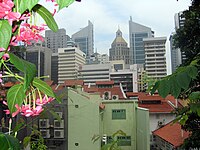
Singaporean English mainly comes from British English.[84] The forms of English spoken in Singapore range from Standard English to a pidgin called Singlish. The Singapore government and many Singaporeans are against using Singlish. There is a "Speak Good English" campaign each year. Public schools and in the media also have rules against Singlish.[85] There are many Singapore accents in English because of the many languages and identities of people in the city. Languages can even change over the generations and children may speak different languages and have different accents from their mother. For example, in a Singaporean Chinese family, the grandmother might speak Hokkien as her first language. Differently, the mother might speak Mandarin as her first language and Hokkien/English as her second languages, while the grandson might speak English as his first language and Mandarin as his second language.
Before independence in 1965, Hokkien, a Chinese dialect, was the common language among the Chinese laborers. Malay and English were used to communicate between the different ethnic groups.[86] After independence in 1965, English became the first language of the nation and replaced Hokkien and Malay as the one shared language. Today, most younger Singaporeans have English as their first language or are fluent in English.
Malay is a national language of Singapore because of the history of the city.[9] However, less than 20% of Singaporeans can read and write in Malay. Malay is still used at home by most Malay Singaporeans.[87] The Malay used in Singapore (Bahasa Melayu) is closer to the language in Malaysia than the language in Indonesia. However, there are differences between the Malay in Singapore and in Malaysia. The national anthem "Majulah Singapura" is sung in Malay.
Many people speak Chinese – Mandarin and other Chinese dialects – in Singapore. Just over 50% of Singaporeans speak it at home, so it is the most common language in homes.[87] Singaporean Mandarin is based on simplified Chinese and it is similar to the system used in mainland China. The forms of Mandarin spoken in Singapore range from Standard Mandarin to a pidgin known as Singdarin. Besides Mandarin, many southern Chinese dialects are also spoken in Singapore.
Hokkien used to be a lingua franca among the Singaporean Chinese so many older Singaporeans still understand Hokkien. The most common Chinese dialects spoken by Singaporeans are the Hokkien, Hainan, Teochew and Cantonese.[86] However, Chinese dialects other than Mandarin are not allowed in the media, so these dialects are quickly dying out. Most younger Singaporeans do not speak them anymore.
Tamil, a South Indian language, is spoken by about half of Indians in Singapore. That is about 5% of all Singaporeans. However, North Indian languages such as Hindi and Punjabi are also spoken by a small group of Singaporean Indians in Singapore.[88]
Culture

Singapore has many kinds of people and immigrants from many places. Therefore, Singaporean culture has often been described as a mix of cultures – European, Malay, Chinese, Indian and Peranakan. Also, foreigners are 42% of the population in Singapore and they are part of changing Singaporean culture.[80][89]
Food

Dining is an important part of life in Singapore.[90] Singaporean food is an example of the many different cultures in the country. It is also an example of mixing among cultures. British, Chinese, Indian, Malay, Tamil, and Indonesian styles of cooking all mix together. It is especially known for its seafood. Typical Singaporean food includes: Satay, Nasi lemak, Chilli crab, Kaya toast, and Hainanese chicken rice, Laksa, Fish Head Curry Archived 2021-11-23 at the Wayback Machine, Hokkien Prawn Mee Archived 2021-11-23 at the Wayback Machine and Char Kway Teow Archived 2021-11-23 at the Wayback Machine.
Media
MediaCorp, the state-owned media corporation, operates all seven local broadcast television channels in Singapore. It also runs 13 radio stations of the total 18 radio stations in Singapore.[91] Radio and television stations are all owned by government controlled companies. However, one radio transmitter in Singapore is not controlled by the government. That is the Far Eastern Relay Station of the BBC World Service.
Print media of Singapore includes 16 newspapers and several magazines. Daily newspapers are published in English, Chinese, Malay, and Tamil.[92]
National flower

The national flower of Singapore is Vanda Miss Joaquim. It is a type of orchid and it is a hybrid orchid. This makes Singapore the only nation in the world to have a hybrid as a national flower. It was chosen because it was part of the effort to create national pride and identity.[93]
Economy

Singapore has a strong and free economy that supports a large middle class.[94] The city state is a global shipping and logistics hub and many multinational firms have their offices in Singapore. The national airline, Singapore Airlines, has a large global network which brings tourists and business travelers alike, to the city. The airline has often been ranked as the world's best airline.[95][96]
Singapore also has a port located at the south of Singapore, called Keppel Harbour. It is one of the busiest ports around the world with many ships coming in to trade in a single day.[97] Singapore also has another port on Jurong Island.

Money
Singapore's currency is the Singapore dollar. The short name for the Singapore dollar is SGD. Brunei dollar can be used in Singapore, because they have the same value.[98]
Geography
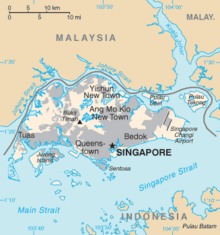
Singapore is made up of 63 islands, including the main island, which is known as Singapore Island to most people, but is also known as Pulau Ujong.[99] There are two man-made connections to Johor, Malaysia: the Johor–Singapore Causeway in the north, and the Tuas Second Link in the west. Jurong Island, Pulau Tekong, Pulau Ubin and Sentosa are the largest of Singapore's smaller islands. The highest natural point is Bukit Timah Hill at 166 m (545 ft).[100]
About 23% of Singapore's land area are forest and nature reserves.[101] Urbanisation has removed most primary rainforest, with Bukit Timah Nature Reserve the only significant remaining forest.[102] Even though there is very little primary rainforest left, there are more than 300 parks and four nature reserves in Singapore. There are also many trees planted all over Singapore and almost fifty per cent of the country is covered by trees and plants. Because of this, Singapore is also commonly known as the 'Garden City'.[103]
Singapore, being a small country, has been reclaiming land from the sea around the island. The first time Singapore started to reclaim land was in the 1960s. The total land area of Singapore at that time was 581.5 km2 and it has increased to 730 km2 in the 2010s, which is an increase of about 20% in total land area.[104] It may grow by another 100 km2 (40 sq mi) by 2030.[105] Some land reclamation projects involve joining smaller islands to make larger islands with more uses, like Jurong Island.[102] Singapore uses the landfill method to reclaim the sea at the south of the country, but polders have been recently used too.[106] The country's rapid reclamation projects has made disputes with its neighbouring countries, Malaysia and Indonesia.[107]
Climate
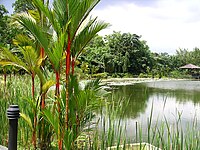
Singapore is hot and wet all year round. It has a tropical rainforest climate (Af in the Köppen climate classification), which means there are no seasons (spring, summer, autumn and winter) in Singapore. There is the most rain at the end of the year, and the temperature is usually around 20 °C to 35 °C.[108][109]
Although Singapore does not experience the four seasons, the period from May to June is usually warmer, while the period from November to January is cooler because of the more frequent rains and monsoonal winds in Singapore during the year-end.[108][109]
| Climate data for Singapore | |||||||||||||
|---|---|---|---|---|---|---|---|---|---|---|---|---|---|
| Month | Jan | Feb | Mar | Apr | May | Jun | Jul | Aug | Sep | Oct | Nov | Dec | Year |
| Record high °C (°F) | 33.5 (92.3) | 32.9 (91.2) | 36.0 (96.8) | 35.8 (96.4) | 35.4 (95.7) | 35.0 (95.0) | 34.0 (93.2) | 34.2 (93.6) | 34.3 (93.7) | 34.6 (94.3) | 34.2 (93.6) | 33.8 (92.8) | 36.0 (96.8) |
| Average high °C (°F) | 29.5 (85.1) | 30.1 (86.2) | 31.6 (88.9) | 31.7 (89.1) | 31.6 (88.9) | 31.3 (88.3) | 30.9 (87.6) | 30.9 (87.6) | 30.9 (87.6) | 31.1 (88.0) | 30.6 (87.1) | 28.9 (84.0) | 31.0 (87.8) |
| Daily mean °C (°F) | 24.5 (76.1) | 26.5 (79.7) | 27.0 (80.6) | 27.4 (81.3) | 27.7 (81.9) | 27.7 (81.9) | 27.4 (81.3) | 27.3 (81.1) | 27.2 (81.0) | 27.0 (80.6) | 26.5 (79.7) | 26.0 (78.8) | 27.0 (80.6) |
| Average low °C (°F) | 23.3 (73.9) | 23.6 (74.5) | 23.9 (75.0) | 24.4 (75.9) | 24.8 (76.6) | 24.8 (76.6) | 24.6 (76.3) | 24.5 (76.1) | 24.2 (75.6) | 24.1 (75.4) | 23.8 (74.8) | 23.5 (74.3) | 24.1 (75.4) |
| Record low °C (°F) | 18.4 (65.1) | 19.3 (66.7) | 20.1 (68.2) | 20.7 (69.3) | 21.2 (70.2) | 20.8 (69.4) | 19.7 (67.5) | 20.2 (68.4) | 20.7 (69.3) | 20.6 (69.1) | 21.1 (70.0) | 20.6 (69.1) | 19.4 (66.9) |
| Average rainfall mm (inches) | 242.4 (9.54) | 161.0 (6.34) | 185.9 (7.32) | 179.3 (7.06) | 172.5 (6.79) | 161.0 (6.34) | 158.6 (6.24) | 175.0 (6.89) | 169.3 (6.67) | 194.0 (7.64) | 256.6 (10.10) | 288.4 (11.35) | 2,344 (92.28) |
| Average rainy days | 15 | 11 | 14 | 15 | 15 | 13 | 13 | 14 | 14 | 16 | 19 | 19 | 178 |
| Average relative humidity (%) | 75.3 | 82.9 | 83.8 | 84.7 | 84.3 | 82.8 | 82.7 | 82.9 | 83.4 | 84.0 | 83.3 | 80.9 | 79.1 |
| Mean monthly sunshine hours | 172.4 | 183.2 | 192.7 | 173.6 | 179.8 | 177.7 | 187.9 | 180.6 | 156.2 | 155.2 | 129.6 | 133.5 | 2,022.4 |
| Source 1: National Environment Agency (Temp 1929–1941 and 1948–2013, Rainfall 1869–2013, Humidity 1929–1941 and 1948–2013, Rain days 1891–2013)[110] | |||||||||||||
| Source 2: NOAA (sun only, 1961—1990)[111] | |||||||||||||
Relations with other countries
Singapore has diplomatic relations with 175 other Sovereign states.[112] Singapore's foreign policy is to maintain a secure environment in Southeast Asia as well as the countries near Southeast Asia. A basic rule is the political and economic stability in Southeast Asia.[113]
ASEAN
Singapore is part of the ASEAN (Association of the South East Asian nations) network, which is an organisation that unites all Southeast Asian countries. Member countries of ASEAN work with and help other countries in ASEAN. Singapore is one of the countries that founded ASEAN, and is the most developed country among them all.[114]
Commonwealth of Nations
Singapore is also part of the Commonwealth of Nations, which is for countries that used to be under the British's rule.[115]
Holidays
Public holidays in Singapore:[116]
- New Year's Day
- Chinese New Year (Chinese Festival) – 2 days
- Good Friday
- Labour Day
- Vesak Day (Buddhist Festival)
- National Day
- Hari Raya Puasa (Malay Festival)
- Deepavali (Indian Festival)
- Hari Raya Haji (Malay Festival)
- Christmas Day
There are also school holidays, lasting one week in March and September, about one month in June, and about one and a half months in November and December.[117]
Records
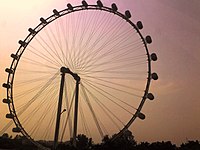

Even though it is a small country, Singapore holds many world records with its buildings and people. Some are:
| Type of record | Name of record | Received record |
|---|---|---|
| Building | For the tallest Ferris wheel in the world | Singapore Flyer[118] |
| Building | For the tallest indoor waterfall in the world | Jewel Changi Airport[119] |
| Sports | Olympic record (OR) at the 100 metres butterfly | Joseph Schooling – 2016 Summer Olympics[120] |
Transportation



Singapore has one of the best infrastructure qualities in the world.[121] Buses, trains, and taxis are easily found.
Most of Singapore are well-connected by a railway system known as the Mass Rapid Transit, or MRT in short. There are also taxi companies like Comfort Cabs, Silver Cab, SMRT Taxis, CityCab and Premier Taxi.[122] There is one telephone number to call a taxi, of which the closest taxi from any company will respond.[123] Apps such as Grab and Gojek as an alternative to taxi companies are also available.
The Mass Rapid Transit of Singapore is the most commonly used form of transportation in Singapore.[124][125]
The Singaporean land transport system is controlled by the LTA (Land Transport Authority) of Singapore.[126]
Airport
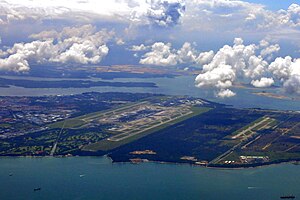
The Singapore Changi Airport is the main airport of Singapore. It is in the east of Singapore, with a total of four terminals with airlines flying to many different parts of the world. It has also received many awards for being the best airport in the world.[127][128] A Skytrain service is also available at the airport.
The airport is in Changi. It is on a 13 square kilometres (5.0 sq mi) site which was reclaimed from the sea.[128]
Notes
References
Other websites
 | Definitions from Wiktionary |
 | Media from Commons |
 | News stories from Wikinews |
 | Quotations from Wikiquote |
 | Source texts from Wikisource |
 | Textbooks from Wikibooks |
| Travel guide from Wikivoyage | |
 | Learning resources from Wikiversity |
- Singapore Food Guide Archived 3 July 2015 at the Wayback Machine
- "Singapore". The World Factbook (2024 ed.). Central Intelligence Agency.
- Singapore's gateway website Archived 5 June 2010 at the Wayback Machine
- Interactive map of Singapore
- Speak good English movement

